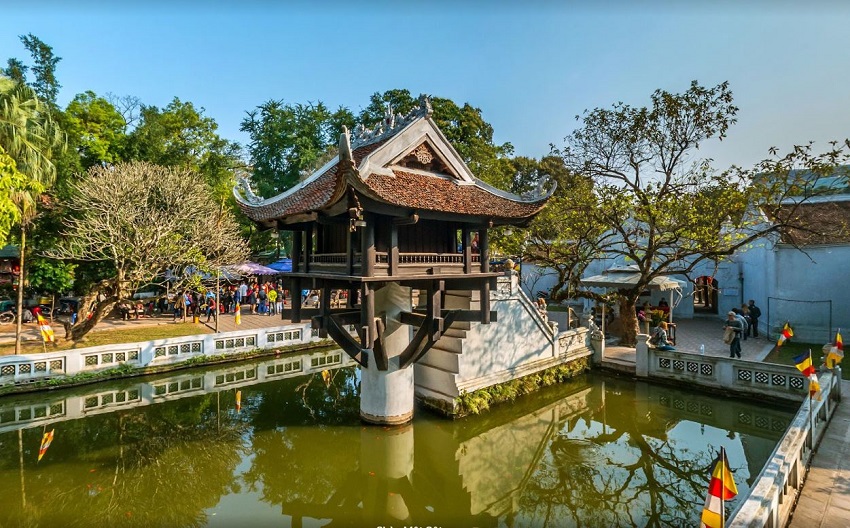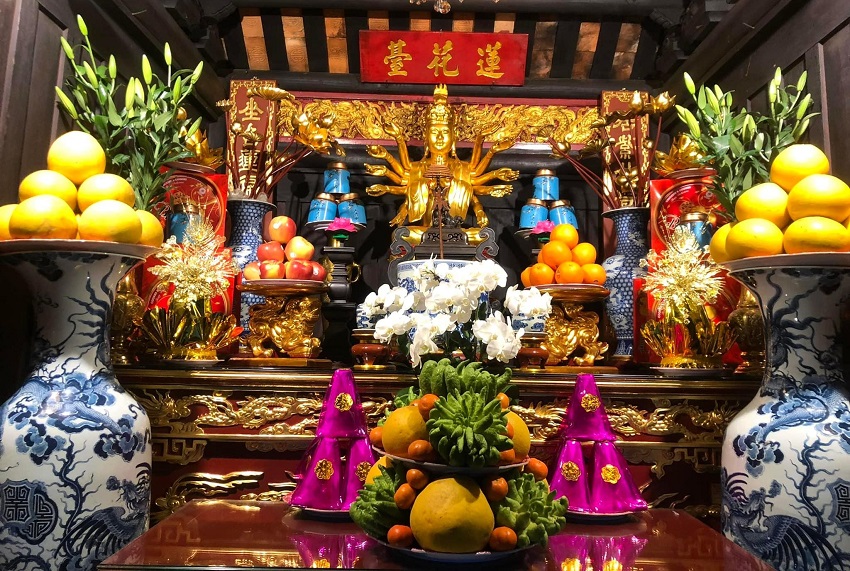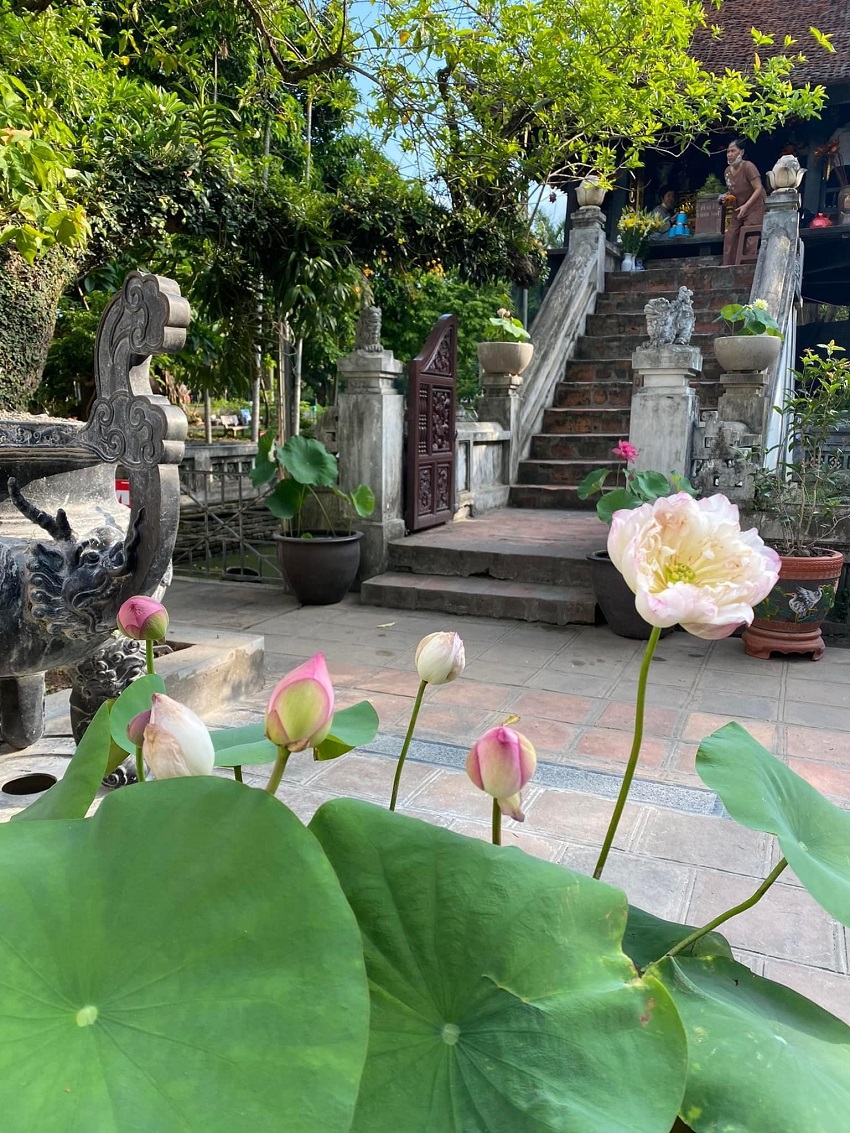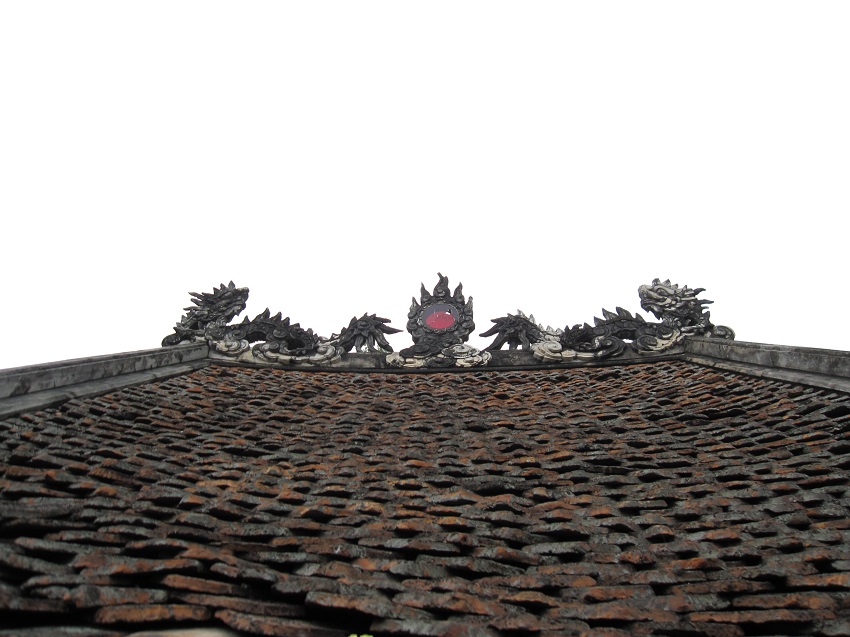Also known as Dien Huu Tu (Pagoda of Permanent Blessings) or Lien Hoa Dai (Lotus Tower), One Pillar Pagoda (or Chua Mot Cot in Vietnamese) is located on the street named Chua Mot Cot in Ba Dinh District, Hanoi.

The funky architecture of One Pillar Pagoda or Dien Huu Tu in Hanoi. Photo: Mottogo
One Pillar Pagoda – a unique structure in Asia
The One Pillar Pagoda was built in 1049, under the reign of King Ly Thai Tong. According to folklore, once in his dream, the childless king saw Phat Ba Quan Am or the Goddess of Mercy sitting on a lotus throne with radiant halo around her head and handing him a baby son.
Ly Thai Tong (1000 -1054) then married a peasant woman he met, and she bore him a son. In the advice of a monk named Thien Tue, and in gratitude to the goddess, the king built a pagoda on a stone pillar, which resembled the lotus throne of his dream.
According to historical records, at the location of today’s One Pillar Pagoda, there was a stone pillar erected in a square pond, supporting a jade tower that housed a statue of Phat Ba Quan Am. The king usually came there for chanting Buddhist scriptures and prayers. Later, the crown prince remodeled the tower into a pagoda and built another 10 meters to the southwest. This complex was named ‘Dien Huu Tu’, with a wish for ‘long-lasting blessings’.
In 1105, under the reign of King Ly Nhan Tong (1072-1127), the pagoda was renovated, while two white porcelain-roofed towers were built in the front yard.
In 1108, under the order of Y Lan Nguyen Phi or Empress Mother Linh Nhan, a bell was cast and called ‘Giac The Chung’ - the Bell of Human Enlightenment, yet it turned out to be too large and heavy for the complex.
It can be seen that the Ly Dynasty was a very was very devoted to Buddhism, and its ruling period is considered the golden age of Buddhism in Vietnamese history.

One Pillar Pagoda in the old days.
A National Historic and Architectural Relic
During the First Indochina War, Dien Huu Tu was dynamited by the French expeditionary force before its withdrawal from Hanoi. After the capital’s liberation, the Ministry of Culture under the Democratic Republic of Vietnam set up a project to restore the tower to its original architecture.
In 1955, the restoration was completed and One Pillar Pagoda has been preserved until now. Nearby still lies another pagoda with a three-entrance gate and a horizontal inscribed board reading: ‘Dien Huu Tu’.
In 1962, the architectural complex in Hanoi was recognized as a National Historic and Architectural Relic. In 2012, One Pillar Pagoda was honored by the Asia Book of Records as a pagoda with a unique architecture in Asia.
Typical Southeast Asian architecture
The structure of the current One Pillar Pagoda includes the pillar, the lotus tower and the roof. Two stone posts were piled to form a vertical pillar with a height of four meters, excluding the underwater part. The pillar’s diameter is 1.2 meter wide, so it looks as firm as a rock.
On top of it, the Lotus Tower has a square shape with three-meter long sides, surrounded by railings and supported by minor wooden pillars above large wooden beams that are firmly attached to the stone pillar. The tower inside is decorated splendidly.

The altar of Phat Ba Quan Am or the Goddess of Mercy inside the One Pillar Pagoda. Photo: Chua Mot Cot
There is an altar lacquered in gold and crimson with cloud motifs, on top of which sits a gilded statue of the thousand-eyed and thousand-armed Goddess of Mercy. Surrounding the statue are many worshiping objects: a pair of ceramic feng shui wealth vases, lotus vases, a set of teapot and cups, and a bronze incense burner. Above the statue hangs a small crimson horizontal inscribed board with three golden words ‘Lien Hoa Dai’.
The roof of the tower is covered with traditional dragon-scale tiles that have become mossy over time. The four eaves were curved upwards like sword blades pointing towards the sky. On top of the roof is the image of two dragons looking towards the moon, a typical architectural feature of Vietnamese pagodas, temples, shrines and communal houses.
The two dragons lie with their tails towards each other, but they bend their bodies to turn their heads towards the moon in the middle. The dragon pair represents yang, while the moon represents yin. The sum is the number three, which symbolizes fertility - that’s why people often burn three incense sticks at a time. This is an image imbued with humanity in Vietnamese spiritual architecture.
A symbol of Buddhism and Nation

One Pillar Pagoda in the nowadays. Photo: Chua Mot Cot
In Buddhist culture, the lotus flower is viewed as a symbol of such virtues as honesty, patience or purity. Lien Hoa Dai is shaped as a lotus placed on a high stone pillar in the heart of Linh Chieu Pond, as if the blossom is reaching out to escape the mundane world - an extremely pure, unique and ethereal image.
Linh Chieu Pond is surrounded by low walls with decorative patterns. To the right of One Pillar Pagoda, there is the larger Bich Tri Lake. In the front yard sits Bach Tuynh stone tower, from which there is a small bridge leading to the pagoda.
Every full moon and first day of a lunar month, the management board here organizes a cleansing ceremony and practice worship in the pagoda.
Visitors also often come for sightseeing as well as wishing for wisdom and vitality. The site is open to visitors on all summer days, while in winter, it is closed every Monday and Friday. No entrance fee is applied here.
Alongside the Temple of Literature, One Pillar Pagoda is now a familiar symbol of the capital, appearing in many books, newspapers and even educational programs. In Ho Chi Minh City, there is also a version of the One Pillar Pagoda, built in Thu Duc District in 1958.
In addition, the image of the One Pillar Pagoda was also printed on the 5,000 Vietnamese dong coin in the past and on the 100,000 Vietnamese dong banknote in the present, as a way to preserve and spread the unique architecture to both locals and tourists.

The roof of One Pillar Pagoda is adorned with the image of "two dragons adoring the moon" - the typical architecture of temple and pagoda in Asian countries. File Photo
Jenna Duong